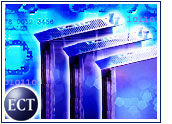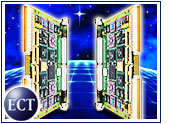
Pushing into new territory as it seeks to solidify its enterprise customer base, Hewlett-Packard has unveiled its entry into the desktop PC blade space.
PC blades use minimal desktop equipment in favor of racked, blade server-style computers. HP is positioning its offering as a more secure, less expensive alternative to traditional networked desktop setups. The blade systems also are being touted because they require less space than even streamlined desktop machines.
HP vice president Keith LeFebvre said desktop blade machines can sharply reduce support costs each year by creating a setup that is “easier to support, maintain and manage.”
LeFebvre said large enterprises, which use multiple applications and are constantly updating systems, can save as much as US$1,200 per year in support costs by using desktop blade setups as part of a larger distributed-computing approach.
Elbowing In
The desktop-blade move comes as HP tries to regain the worldwide PC sales crown it recently lost to Dell, which appears to be picking up market share in the enterprise space and threatening to siphon more revenue from both HP and IBM.
To date, the blade-PC market has been dominated by ClearCube Technology, which helped establish market demand for the technology.
Sound System
The ability to reduce the number of independently operating desktops tied to a network is a winning strategy for enterprises, Gartner vice president John Pescatore told the E-Commerce Times.
“The idea of having more computing power right in the datacenter or server room where it can be monitored and secured better makes sense,” he said. “Desktops create a number of security concerns, and this approach does address some of them.”
HP’s bc1000 line, which uses Transmeta chips, was made available to North American customers Monday, with the machines carrying a price tag of US$820 each. HP also is offering a package that includes its thin-client device — which connects desktops to the blades — as well as storage and installation for $1,400 per user.
CC Rider
The blade PC is part of HP’s overall Consolidated Client Infrastructure (CCI), a strategy for maximizing computing power through use of various techniques and tools, such as virtualization software and storage devices. The company pointed out that some enterprises can have users share the blades, reducing the need to buy computing power by using the client device to distribute it where it is needed.
IDC analyst Roger Kay told the E-Commerce Times that the timing of HP’s move may be right because businesses are starting to replace older desktops at a faster clip.
“This gives them an alternative to offer their enterprise customers,” Kay said. Also, because the blades are positioned as part of the overall CCI effort, they may allow HP to boost revenue by selling additional features and services to customers even though those customers are reducing their PC costs.
Kay noted that Dell has yet to launch an equivalent to HP’s CCI and IBM’s on-demand strategies, which may help those companies fend off Dell’s charge in the enterprise area.
HP cited research showing that traditional PCs can cost $8,000 to maintain through their life cycle, an amount that can be reduced by as much as 50 percent in some settings with CCI.














































Social Media
See all Social Media